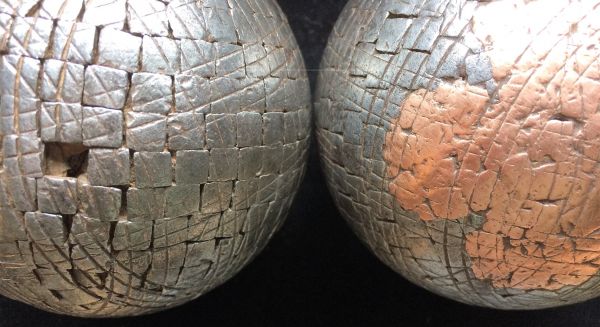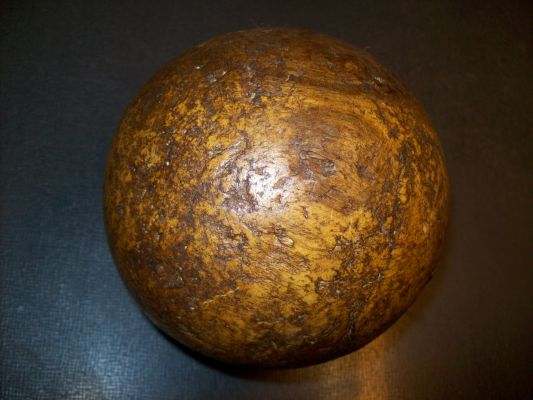
1) Unusual and beautiful objects, these treasures created in France bear witness of a time when I would like to make a little incursion.
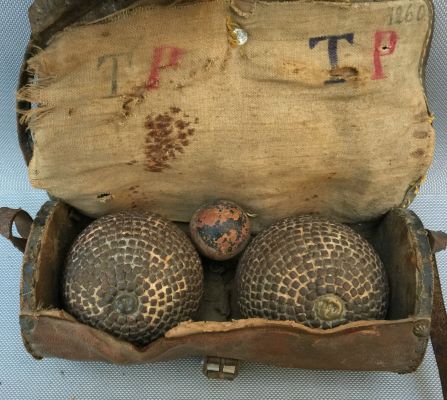
2) Each ball has its own history, it passed from hand to hand during the ‘’parties de boules‘’. Some of them are really artworks… with an unique feature: ‘’artworks destined to survive the violent shocks and other mistreatments‘’.
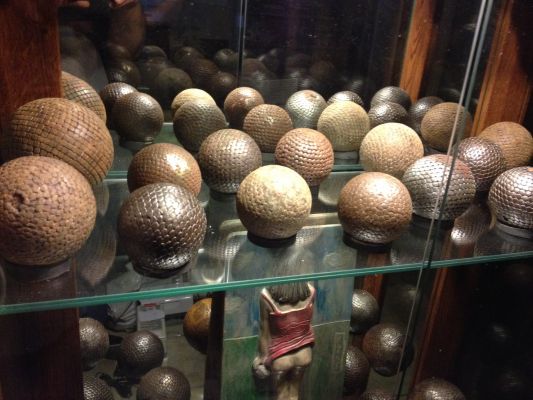
3/1) Until the end of 19th century, turned from wood, the balls were already perfectly spheric. In many cases Boxwood roots was used because very dense and therefore appreciated for its toughness. (first picture diam.108mm – 680gr) ‘’The story of the ball is naturally linked to the possibilities of manufacturing of the epoch.‘’ Originally existed balls from different woods with different textures as below.

3/2) To begin, here is a beautiful document to get in the mood for the times, in the late afternoon. In view of the clothes, it is a day of celebration, unless it is just a Sunday. (click)

4/1) Until the mid 19th century, people played with wooden balls: boxwood, beech or elm. Some were partially nailed but …‘’ These wooden balls had a weak point : subject to wear they were distorted, especially if the game was played on hard and stony ground.‘’ (like the comment of photo number 1, extract from the website: http://herbert.wegner.pagesperso-orange.fr/)
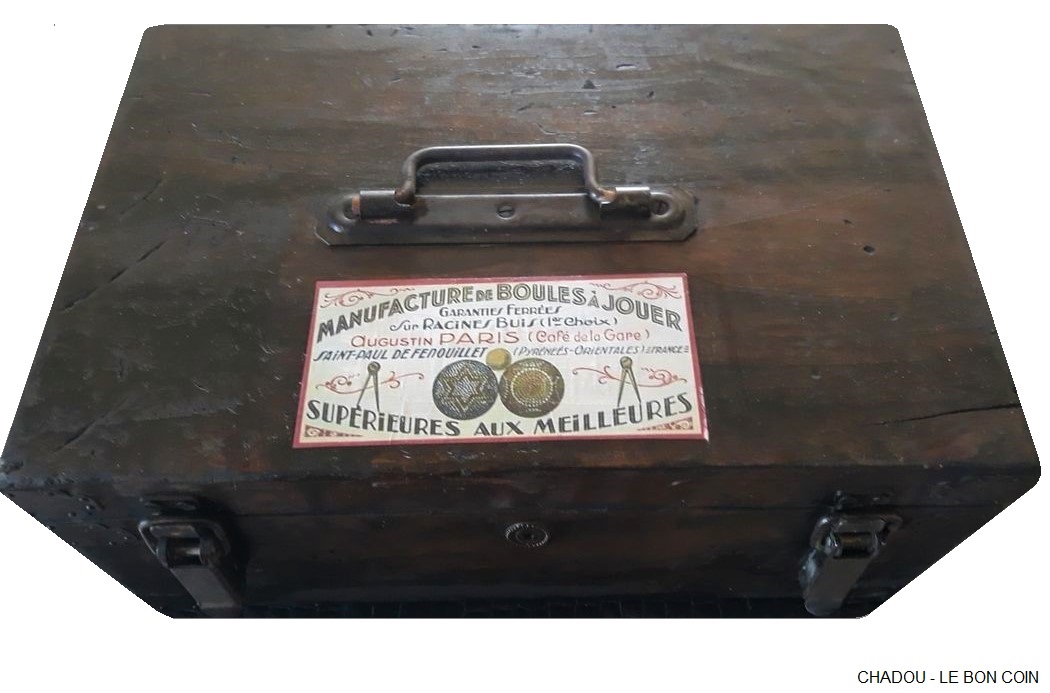
http://herbert.wegner.pagesperso-orange.fr
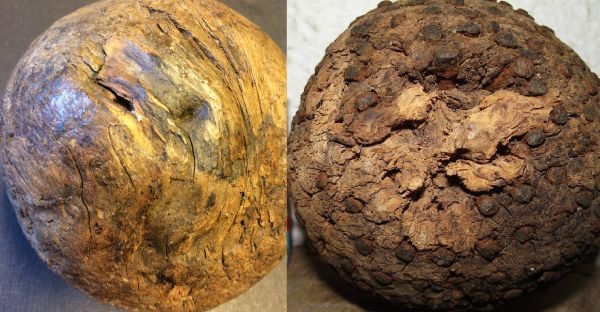
4/2) The ideal wood for nailing is the root of boxwood. The texture of boxwood ensures its strength, the ball cannot entirely split in the direction of the fiber because there is no direction, only knots.
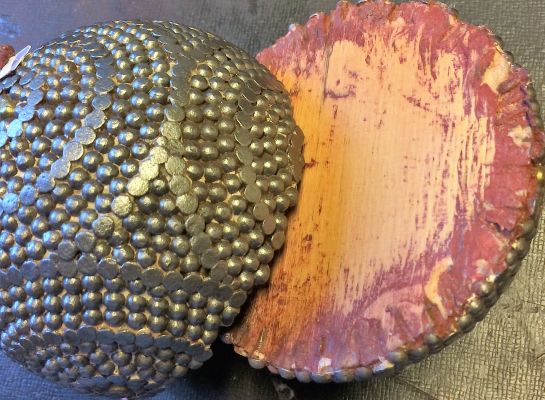
4/3) On the other hand, this very beautiful studded ball is not made in boxwood, unfortunately it is beech, although hardwood but with parallel fibers. Weakened by nailing and under the effect of successive heavy shocks, finally she broke.

5) Here is a set of balls garnished with spaced nails, they were colored for an easier recognition. Looking at their head it seems to be screws but those are nails. They have to protect the surface of the balls against shocks and abrasion. (diameter 98mm). Not boxwood, this wood is less dense with a different texture. Partially studded they preceded the fully studded balls (seen lower). Paradoxically, this nail seems to have been made mechanically. (1 or 2 ‘’click‘’ on the pic to enlarge)

6/1) The above ball (100mm) shows a rudimentary nailing, it is probably elm wood, even older than the eight above balls. One ‘click’ on the picture to see the hand forged nails.

6/2) This heavy ball is studded with hand-forged nails. The square heads have four beveled sides. With an extreme density and resistance thanks to the knots, boxwood becomes the standard: here 10 cm = 930 gr. (click)
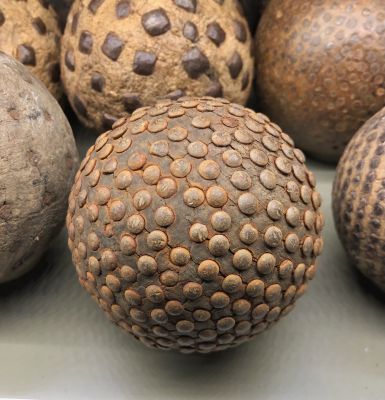
6/3) Another nailing of the origins. It is a boxwood ball of ‘’jeu provençal‘’ weighing 550gr with a diameter of 90 mm. Under the nails, still spaced, we can see the lines drawn on the wood whose intersections served as reference points. (click)

7/1) Evolution: on this heavy ball in very dense boxwood (8.8 cm / 465 gr) the nailing is less rudimentary, in order to improve their aesthetic appearance the nails were neatly lined.

7/2) With this heavy ball in very dense knotty boxwood we are still almost in « archaeology ». It weighs 542 gr for a diameter of 92mm. The summary decoration made of small nails arranged in concentric circles tells us that it dates from the middle of the 19th century.

8/1) The sophistication of decoration takes shape. These two balls are noticeably of boxwood, very dense. (11.2 cm = 705/730 gr) Pics https://www.ebay.fr/str/papyrouge

8/2) A more advanced stage, same kind of pattern, but this one was polished then colored. (Image “borrowed” from the internet)

8/3) Here is the same manufacturing. Picture received from the website ‘’Jeux Anciens‘’ (games from the past) http://jeux-anciens.fr/categorie/boules/ They lived but visibly these were well maintained.
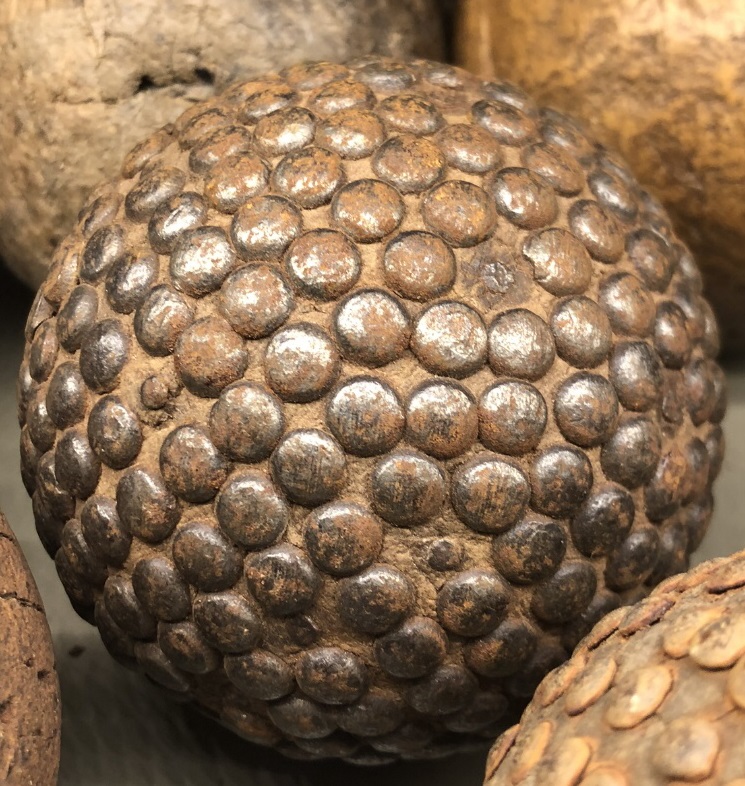
9/1) ROUND SHAPED NAILS – The nailing of the balls began in the second half of the 19th century, it was about nails with small head or almost headless. At first the nailing was random then gradually organized; later, a particular care was taken in the alignment to achieve a real decoration. The most widespread basic ball showed nails with a broad and rounded head, sometimes a little flattened, in english called (…I think) « frustoconical head » (see 10 to 12). This one, lesser known shows very flat nails with rounded edges; although they do not always touch each other perfectly, they cover almost the entire surface and are part of the transition between the scattered nails of the beginning and the « real » studded balls with the great variety of achievements that followed.
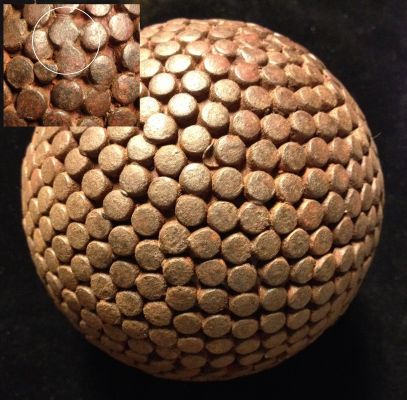
9/2)* Here, the round heads are flattened. The deformation of some nails is due to violent shocks.
In the last quarter of the 19th century the nails were made mechanically, making easier the manufacturing of balls with the advantage of protecting them from spoilage and wear. The first ones garnished in this way were reinforced by iron nails with a large round head. The ball shown below (95 mm) ‘would have been’ according to its former owner, made by a convict. ↓ (but no document supports this hypothesis.)
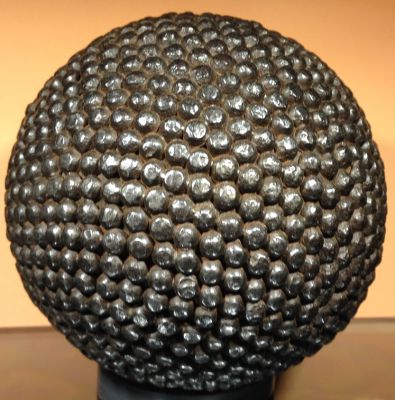
10) Due to the nails, balls became heavier with a diameter of 100 to 150 mm and a weight of up to 1500g, particularly those of the game ‘Lyonnaise’. Later nails with square head or flat head nails were used. Starting from that moment, artisans becames real artists, the nails were made with several materials and colors (iron, copper, brass) which allowed to make symbols, numbers or initials as well as stars and other drawings according to wishes of the players. The two balls below (100 mm) are covered with nails made mechanically.
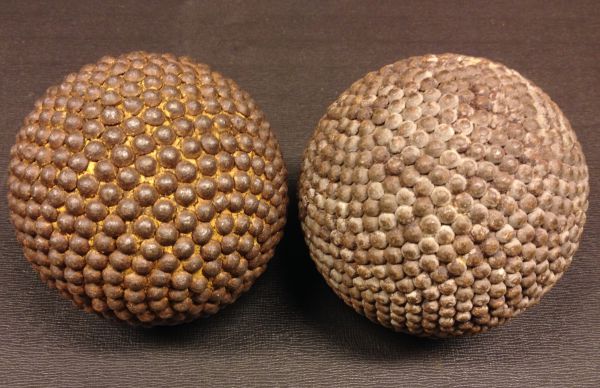
11/1) Originally, the balls were simply covered with rounded heads nails.
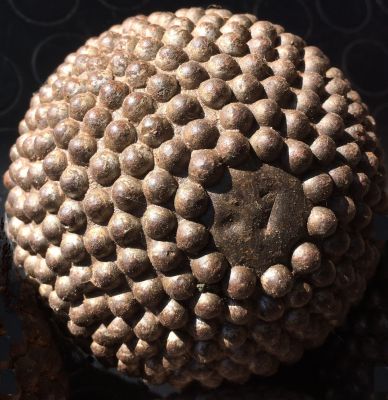
11/2) Seen under different lightning, a ‘’click‘’ to appreciate the details
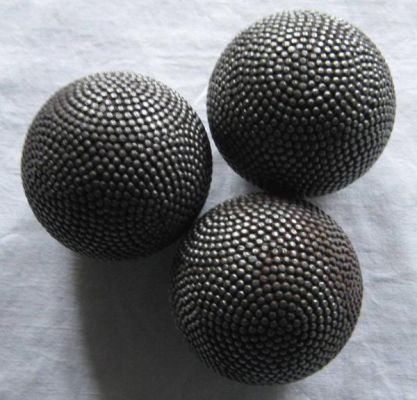
11/3) Usually the basic balls were simply covered with nails with rounded heads, they rarely showed original patterns. Here are three beautiful balls which are more original because each one is decorated with six sets of concentric circles. (Seen on the page « chinons.fr ».)
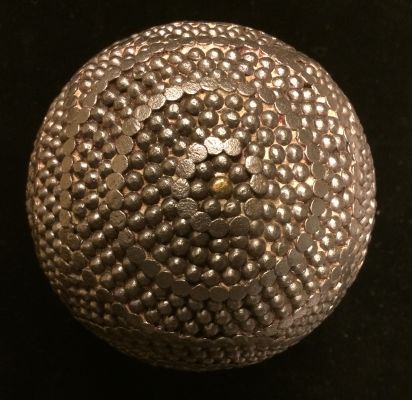
11/4) Aesthetic combination of bulged and flat heads. As on the photo n°25, despite their very short tip and the shocks collected, these nails miraculously remained in place. (1x click)
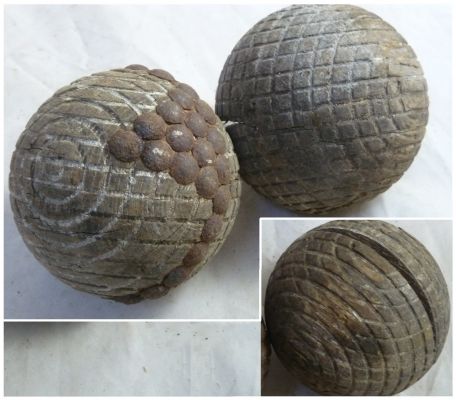
12) Lines engraved by the wood lathe. Were they guidelines for hammering nails? On this ball appears a beginning of process. The split ball shows the possible bad surprises of drying. It must be beech wood, because a boxwood root ball would not split.
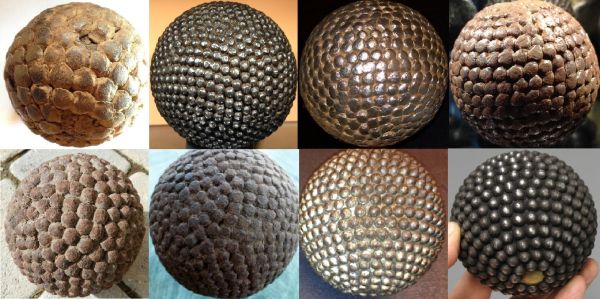
13) Balls covered with round head nails ranked (about) from the oldest to the most recent. Based on the fact that on the ball each head is different, the first 6 balls seems forged by hand. One ‘’click‘’ to see the details.

14) There is a lot of variants. Here few nails but they have big heads. (100 mm)

15) Another original form: domed hexagonal and tightly fitting nails. (Ebay picture)

16) Older, this little ball of ‘’Provençal game‘’ (75mm 557 gr) is still covered with hand-forged nails. Since then, the Provençal game was supplanted by the popular ‘’petanque‘’ officialized in 1910. If you understand french, maybe with ‘’Google translation‘’ and if you want to know more, open this link: http://www.blogpetanque.com/pontault77/Histoire-de-la-Petanque_r11.html

17/1) Above and below, even older a little jewel probably from the late 19th century. One ‘’click‘’ on this ball of Provençal game (80mm) will reveal details on the heads of the spikes worked by craftsmen so they overlap a little in order to get a smoother surface. On the enlarged picture, the knotty and highly hard boxwood can be seen clearly. The heads have disappeared but their spikes imprisoned remain in place forever.
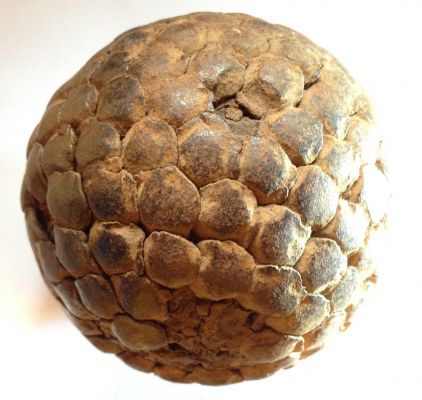
17/2) The same from another angle.
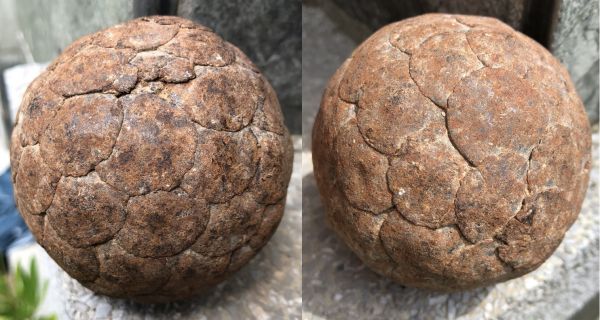
18/1) Thanks to the kind collaboration of Mr. Serge Maren from Montélimar, this very old ball enriches the collection. The scales that cover it are the largest of all. (diameter 79 mm)
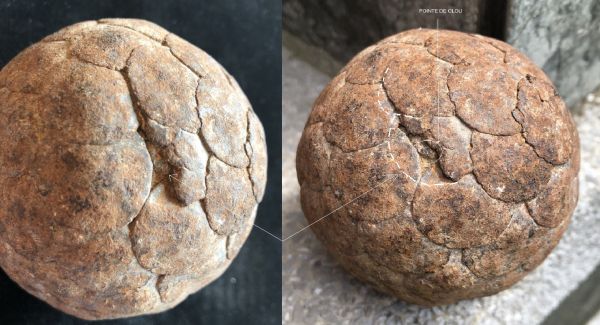
18/2) The head of this nail is missing, see its tip (pointe de clou) that remained lodged in the wood. This very old specimen is covered with hand forged nails. The edge of the scales is very thin, while the center is much more thick which explains the high weight, 826 gr.
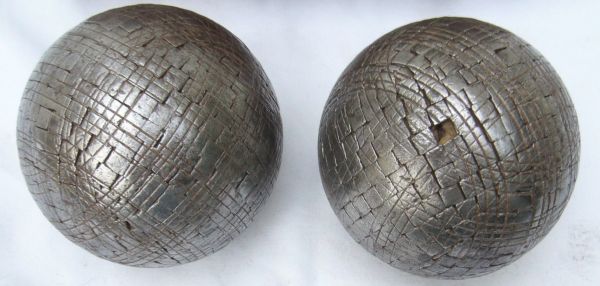
19/1A) A weird ball. Realized at the beginning of the 20th century with square heads nails, these two balls are decorated with a copper clover whose rounded edges were particularly neat with small nails adapted (click). Due to hard shocks, these clovers in soft copper merged with the iron sometimes giving the impression that the same head is composed of two different metals (see details below). Circles that intersect were engraved later, these are the ones that decorate the modern metal balls, these circles come to increase the confusion. The whole is unusual and unique.
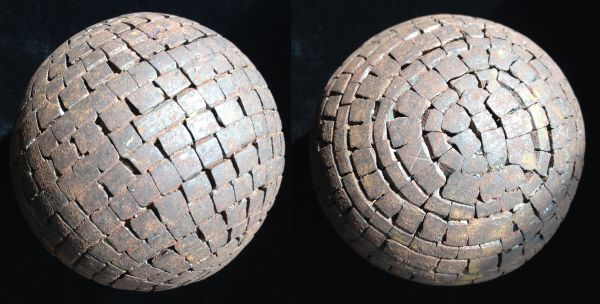
19/2) Another enigma. Strange ball, probably a rare and precious piece. Many nails are beveled, each nail is different, head angles are sharp as if each head had been sheared rather than forged … this is an enigma. The ball is very heavy, with a diameter of 98mm it weighs 1.390 kg and yet she remained perfectly round without asperities. Below, one click to see the four roman numerals engraved apparently with a chisel. Referring to it, should date from 1924.
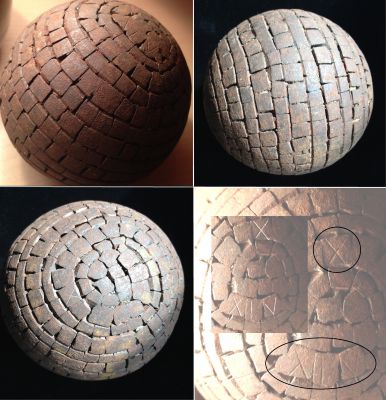
20) Below we are reaching the perfection. This is a very old ball and probably unique due to the perfectly adjusted nails. All are different, they had to be forged manually and individually adjusted. (1 ‘’click‘’) This exceptional ball from 1904 was found on this website : ‘’la Boule Sportive Aigue Mortaise‘’. http://www.blogpetanque.com/BSAM/photos/la-boule-cloutee_gp2050523.html In my eyes, she has only one flaw: ‘’she’s not mine‘’.. 🙂
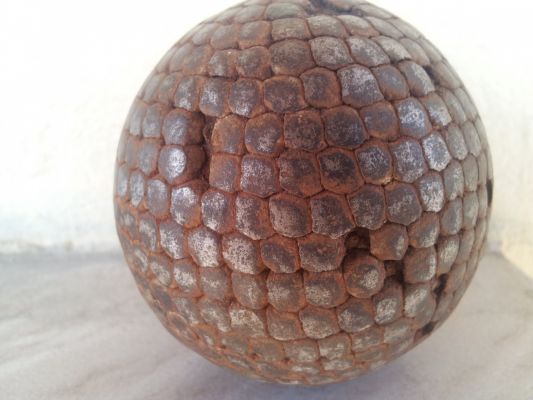
21) Some balls are more meaningful and even more beautiful when not get rid of rust, dirt and other inlays that load them with ‘’static authenticity‘’. —————————————————————————–
Now we come to … LA FANNY!
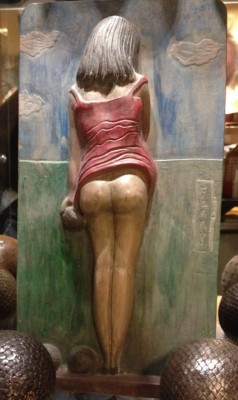
22/1) The pétanque without ‘’La Fanny‘’ is not the pétanque. Originally, the losers had to kiss the ‘’popotin‘’ (butt) of a young woman named Fanny shown in table form, pottery or sculpture. Today ‘’La Fanny‘’ is more present by antique shops and on flea markets that in bars and coffee shops but any serious pétanque club must have one Fanny at his headquarters. This icon is part of their heritage. At the origin of the origin there is the story of Fanny, probably a true story, more realistic both funny and pathetic. A fact of the village as it is occuring everywhere over in a time when people laughed kindly… or not, about people seeming to be ‘’different‘’ In order to learn more about it there Phoebus Garcon page: https://www.facebook.com/notes/la-p%C3%A9tanque-fort-mahonnaise/lhistoire-de-fanny/1011387195543585 (in french) Kissing the buttocks of the Fanny is the humiliating picture of total defeat, the evidence that has been beaten thoroughly with the score of 13-0! Attention… when we say ‘’humiliating picture‘’ … it’s with nuances because after the pétanque party the discussion occurs at the ‘’café de la mairie‘’ (= bar of the town hall) around ‘’the pastis of reconciliation‘’. That being said … is she not cute my little Fanny?

22/2) The same Fanny is mentioned on page 30 of a very beautiful book devoted to petanque.
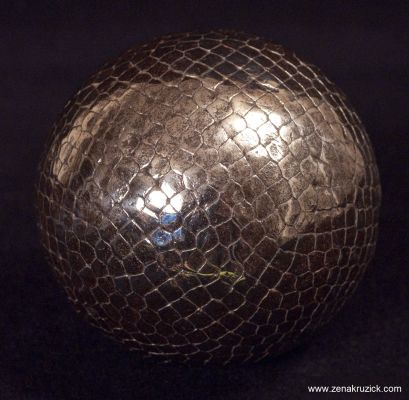
23/1) SHINY BALLS –Studded balls are often artworks mainly performed by women. (On this ball each nail is different, see yourself the precision of adjustments) During manufacturing by their expert hands, a badly positioned nail meant probably a condemned ball because wood does not tolerate two contiguous attempts. As with the next two, this is stainless steel; did this kind of steel already exist at the beginning of the 20th century? The answer is easily found on Wikipedia, it is “yes”.
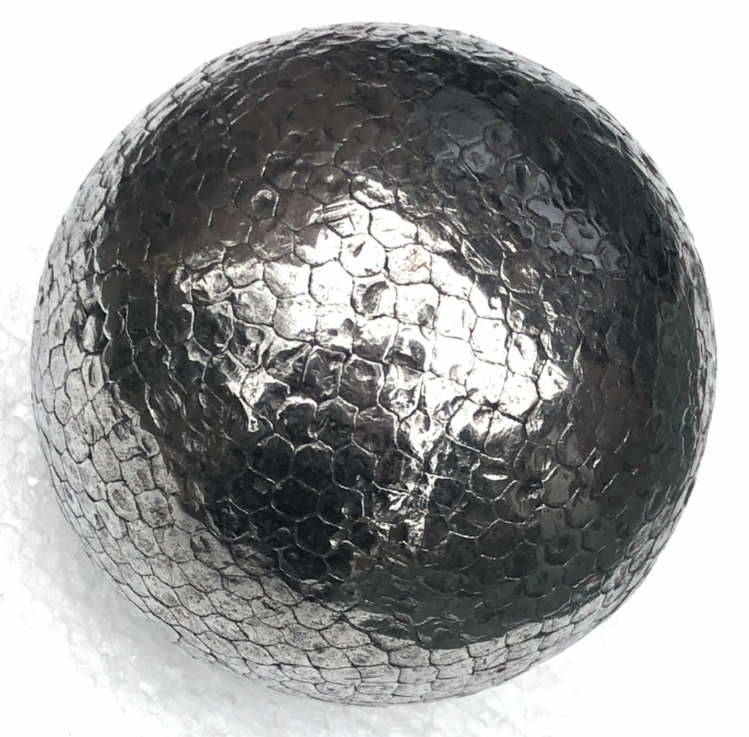
23/2) SHINY BALLS – Another rare ball similar to the previous one, click to better see that no two nails are identical.

23/3) SHINY BALLS – Just like the one above, this beautiful ball is covered with nails that do not require any treatment to restore its original shine. Obviously it is stainless steel; did stainless steel already exist at the start of the 20th century? The answer can be found quickly on Wikipedia and it is ‘’yes‘’. (click)
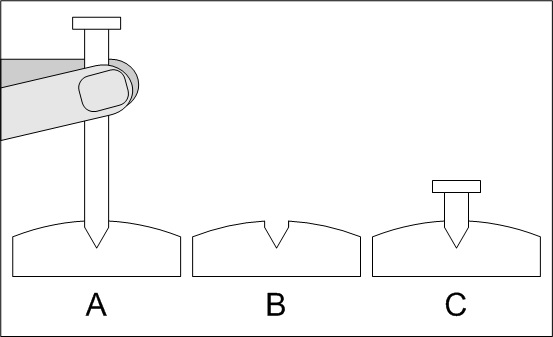
24) One hypothesis among others: each nail location was labeled in advance and also the letters or drawings that must be created with different sorts of nails. The diagram shows that the location of each nail was determined beforehand by a small hole. This made it possible to respect the pattern and also to introduce the nail so that it remained in the right position to receive the hammer blow. (Thanks to Steve Ferg, Tucson USA – access to all of his work: fig 35) It is surprising that despite their short spikes and countless received shocks, these nails have remained in place for a century… but to be honest, not really always. (see picture below)
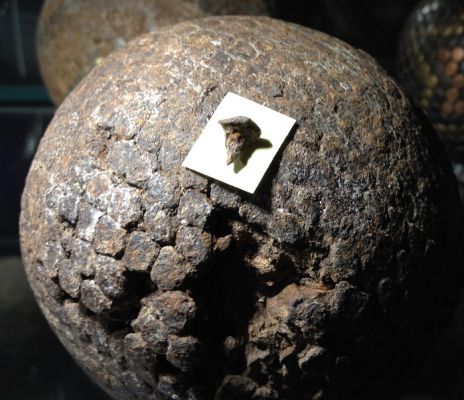
25) These balls were therefore intended to collect countless shocks. Here are a few examples, originally rusty and impregnated of soil, some were scrubbed and shined to bring out the details, but as was said above, it is sometimes better to leave them in their original state.
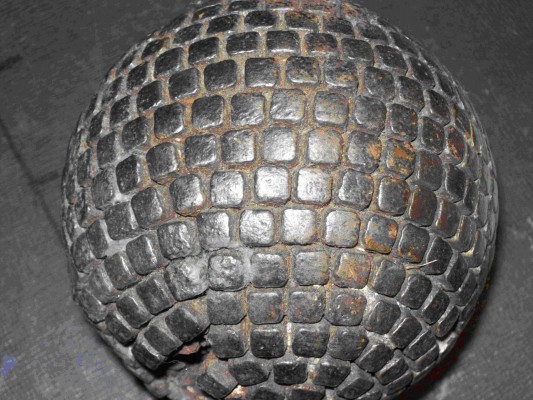
26) COBBLESTONES-LIKE NAILS – nails arranged as paving stones. (93mm)

27/1) This nailed ball has lived, she reveals her underwear. The damaged area shows the thickness of the heads. The missing nails do not reduce the pleasure to contemplate it.

27/2) These square head nails are sometimes referred to as ‘’horseshoe nails‘’ which can be confusing. In fact it evokes the nails in this photo, square heads with long and folding points which are used to shoe the horses but it is not because here the points are very short and they are indeed ‘’nails to shoe the boules‘’. (click)
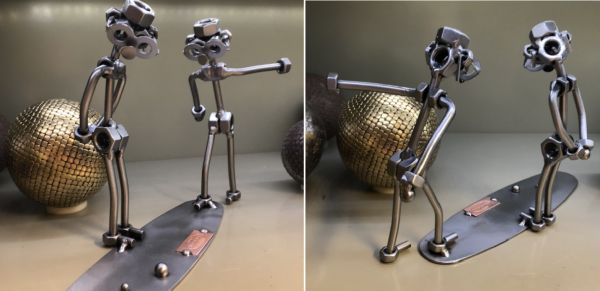
27/3) Not studded balls but… balls and bolts.
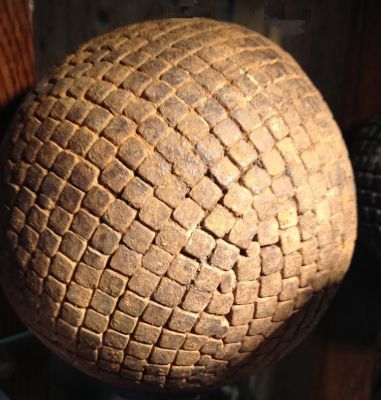
28) On this one not restored (105 mm) the nails are also disposed as a pavement but with a different configuration: nails with a slighty thinner head were used which has reduced the interstices.

29*) A nice ball, also with square head nails, maybe upholstery nails because their heads are thinner than usual. A wave movement makes it original.

30) Some square heads of different sizes.
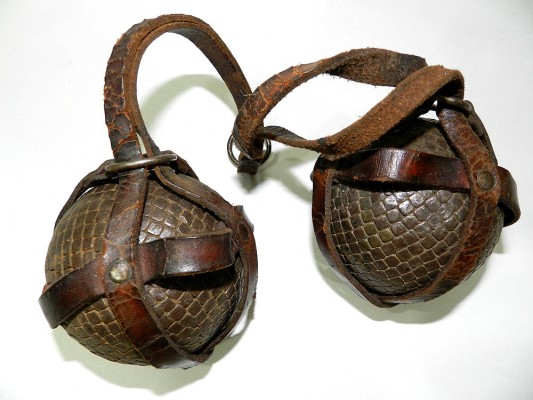
31) Small petanque balls with nails arranged in paving stone in their leather carrying harness.
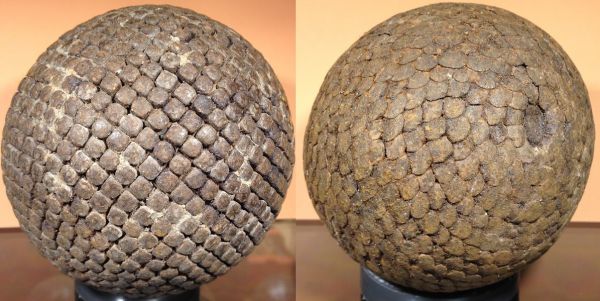
32) Two different balls remained ‘’in their own juice‘’ (dans leur jus = without restauration) as people say in France.

33) NAILS IN SCALES – On this large boule (105mm) you see nails with flat head. Their thin heads overlap such as slates on a roof. If you passes the finger ‘’against the grain‘’ the rough edges are barely noticeable because in addition, soil and shocks made the surface smoother.
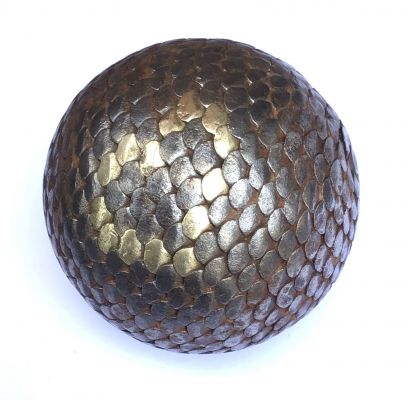
33/2) Creating figures like this heart on a small ball with scale nails is not easy. (72 mm-485 gr) For this reason the patterns are simple and this ball is a rare piece. Apart from this brass heart, the overlap of the small iron scales is impeccable (click). Note: we can see another realization of this type in position 23/2 while the second example which follows is confusing: the nr 67/3 which, although resembling a ball in scales is not one because the heads nails do not overlap but they are contiguous.
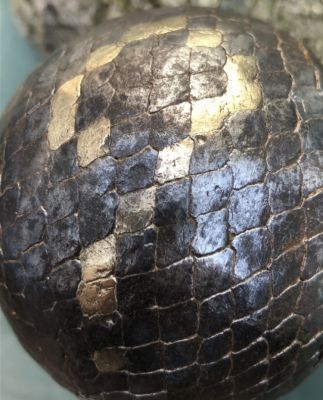
33-3) A ‘’jeu provençal‘’ boule. (jeu=game) A ball (80mm-668gr) with this original figure, a question mark. Was this ball studded in scales? No, there is no overlap, in this case the nails heads are perfectly adjusted against each other. One click to see before and after stripping. It was already said above (25) it is sometimes preferable to keep a ball in its initial state
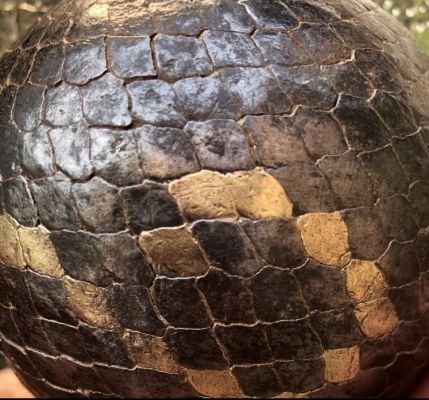
33/4) The technique of nailing (shoeing-ferrage) this ball decorated with a question mark is the pinnacle of what was done at the time. One click to see that the scales are all different, so they were forged manually.
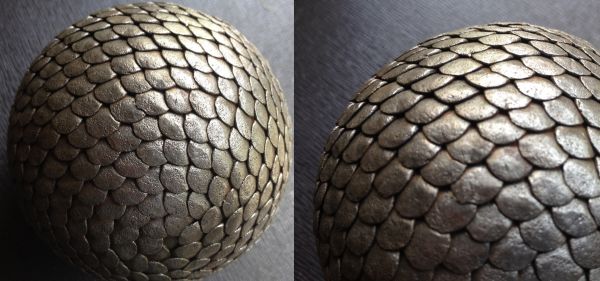
34/1) This one (78mm) is in perfect condition, cleaned even more she was pickled and apparently she did not play much because its nails are barely distorted and very little marked by impacts, however they seem pricked by the acid. About scales, see the picture 34/3.
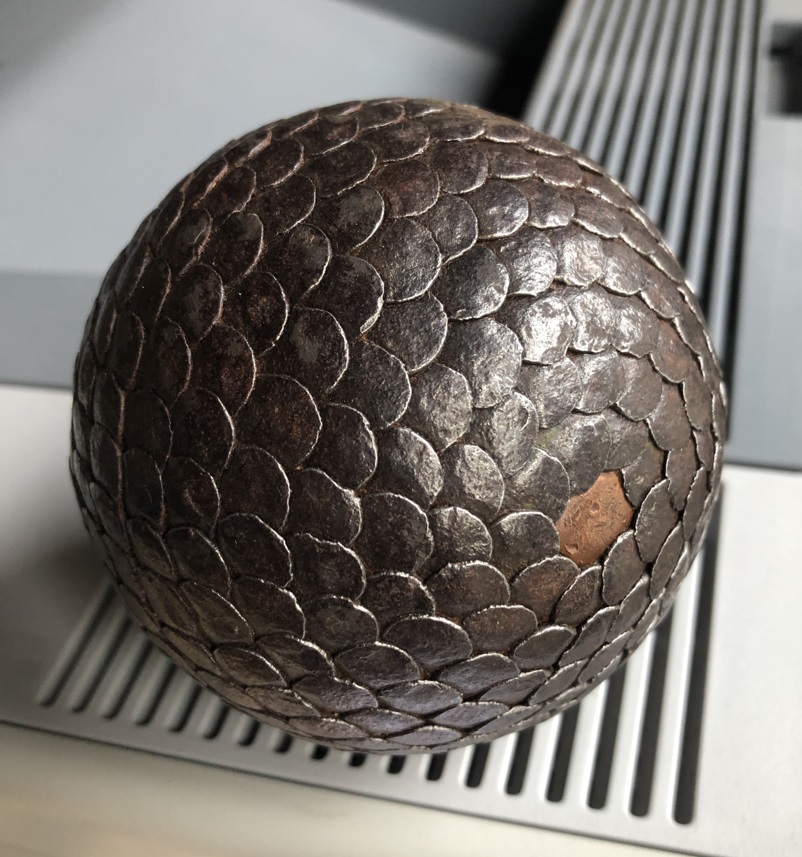
34/2) Superimposed scales. A simple work but beautiful work. One click to see the point of a nail that has lost its head and the large finishing nail that has disappeared.
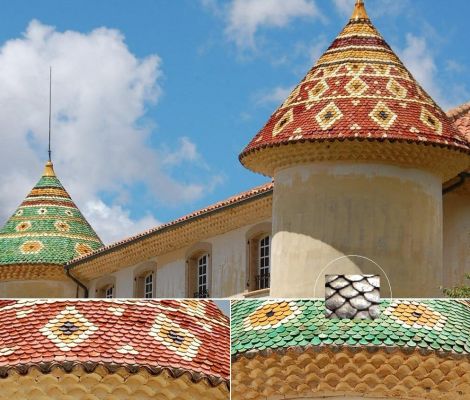
34/3) The castle of Aiguines. (France-Var, the village is still mentioned under the following pic) One click to compare its tiles with the shells of the studded balls made on the spot. It was more than a century ago.

35/1) A ball with contiguous scales (90mm) … but this is not entirely the reality because each nail head has a folded portion that disappears under the following nail head. Result of this technical: a smooth ball with the impression that the nails are placed against each other, a real artwork! ‘’If the village of Aiguines in the Var was the temple of manufacturing of studded balls, this is not a coincidence because it was located in an area where the boxwood grew in abundance. The roots of this particularly hard wood were the ideal material for manufacturing of pétanque balls. Aiguines with its workshops of wood turners therefore naturally specializes in manufacturing of studded balls.‘’ Steve Ferg an American lover of France and expert in Pétanque devoted himself to the reconstitution of the methods of manufacture of studded balls. In the year 2018 he publishes the results of his researches and experiments: https://petanque.wordpress.com/recreating_a_nailed_boule/

35/2) This is the step upstream of the boule nailing process. The photo would come from the museum of woodturners in Aiguines. A somewhat amateurishly restored document in order to rid it of the halos from blinding light bulbs. Nevertheless, it reproduces the warm atmosphere of these old workshops well, all that is missing is smell of oil and wood dust.
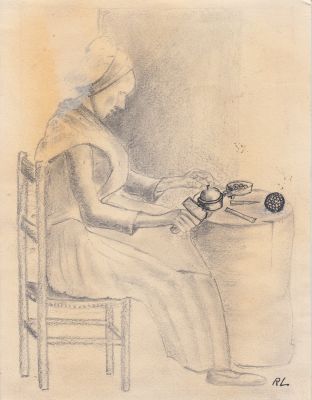
36/1) Year 1939, a ‘’ferreuse‘’ in the village of Aiguines. The documents on this subject are rare. This beautiful drawing was made by Roger Lacombe, a collector of old balls of petanque living in Fréjus. As teenager in the 1950s and already before, he loved watching animated ‘’parties de boules‘’ in the neighborhood.
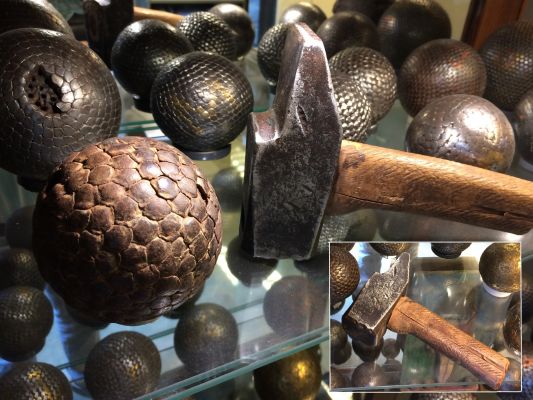
36/2) Le marteau (the hammer) of a ‘’ferreuse‘’. There were hammers with both sides square, and like here those with a flattened side. The handle is a faithful copy made by Angel Zenasni from Draguignan. (an archaeologist of the petanque 🙂 )
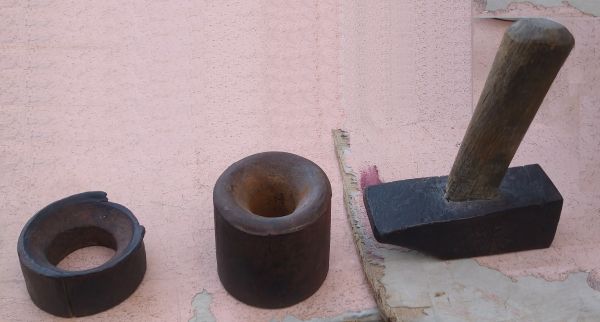
36/3) L’enclume (the anvil) – Over time, progress is made in the knowledge of the boules manufacturing process (or processes). In terms of tooling, until today we had never seen any allusions to the word ‘’enclume’’(anvil) only the terms ‘’billot (chopping block) = cepoun’’ – ‘’rond de cepoun’’ – ‘’marteau’’ (hammer) – ‘’clous’’ (nails) we were known. We received this picture from Mr. Angel Zenasni of Draguignan who teaches us the existence of this object and gives us these explanations: The ‘’enclume’’ was the tool used to standardize the driving of nails, it advantageously replaced the simple ‘’round de cepoun’’. While the nails were driven by the hammer, each stroke was reflected on the underside of the ball in its housing that perfectly matched its shape to finally get an homogeneous studding. The base of the anvil itself was enclosed in a piece of wood so as not to move and obtain ideal studding conditions.
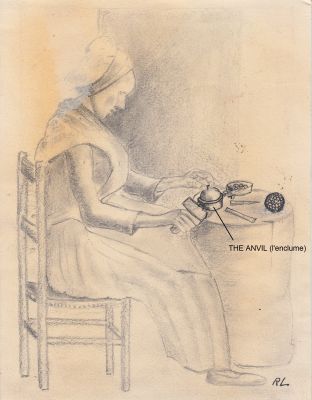
36/4) Roger Lacombe the precursor. By ignorance, we did not notice it, only now we discover the anvil on his drawing instead of a ”rond de cepoun”.

36/5) Another beautiful anvil (1.730 gr) from the flea market in Draguignan (booth of Ange Zenasni). Draguignan located less than an hour from Aiguines the cradle of the studded boules.
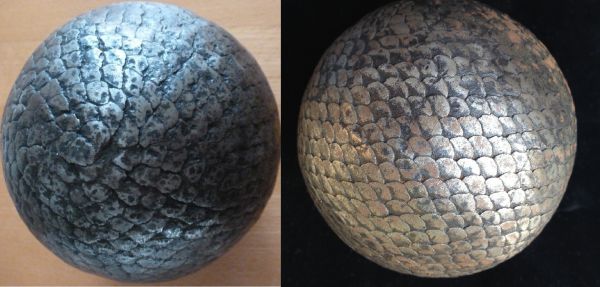
37) Under two different lightnings, another ball of ‘’longue lyonnaise‘’ (90mm) very smooth with thin scales perfectly adjusted, they overlap without any roughness. Impressive, this is almost an artwork, a heavy piece that is pleasant to turn in the palm of the hand.

38) Because of injuries we can better discover the technique that allowed to manufacture these very smooth balls: each scale (slate) is curved so that the head of the next nail covers the previous one without creating asperity.
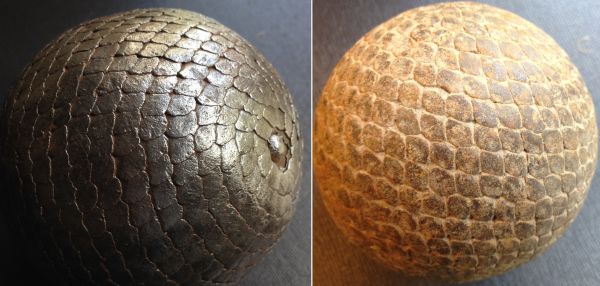
39) This picture shows two marvelous balls without asperities. To the left we can see the same method while the ball on right is covered in nails whose head is a lozenge, heads perfectly adjusted against each other without overlapping.

40/1) Two balls with almost the same diameter (75mm) but the left one would have been more difficult to make because its nails are smaller. Better finishing for a better grip and maybe better performances on the field? One or two ‘’click‘’ to see the details to admire a so perfect nailing and an overlap on extremely resistant balls. These undecorated balls are art works made without the ambition of making art, anonymously and simply for a popular game. See it closely, there is none nail moved despite shocks received as evidenced by the many traces of visible impacts on the scales.
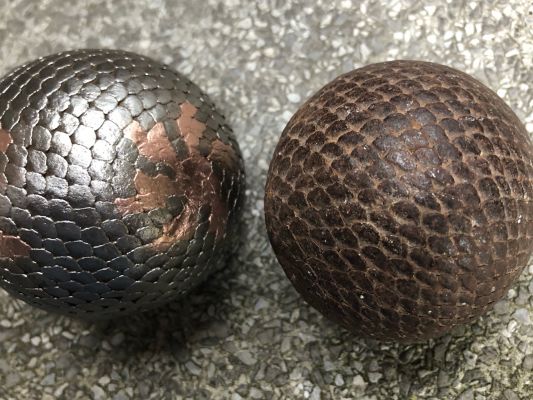
40/2a) Summer 2021 Robiac-Cévennes. These two beautiful, intact little balls (75mm – 565 gr) have spent many decades in a box until Mr. Y. Billon offers them to me ‘’they will be highlighted, they deserve to come out of anonymity‘’ was his remark. Thank you for this beautiful gift!

40/2b) Here again are the boules of Robiac-Rochessadoule, the first remained ‘’dans son jus‘’ (as the French say = in its current state, without sanding) while the other, scoured, reveals unsuspected patterns
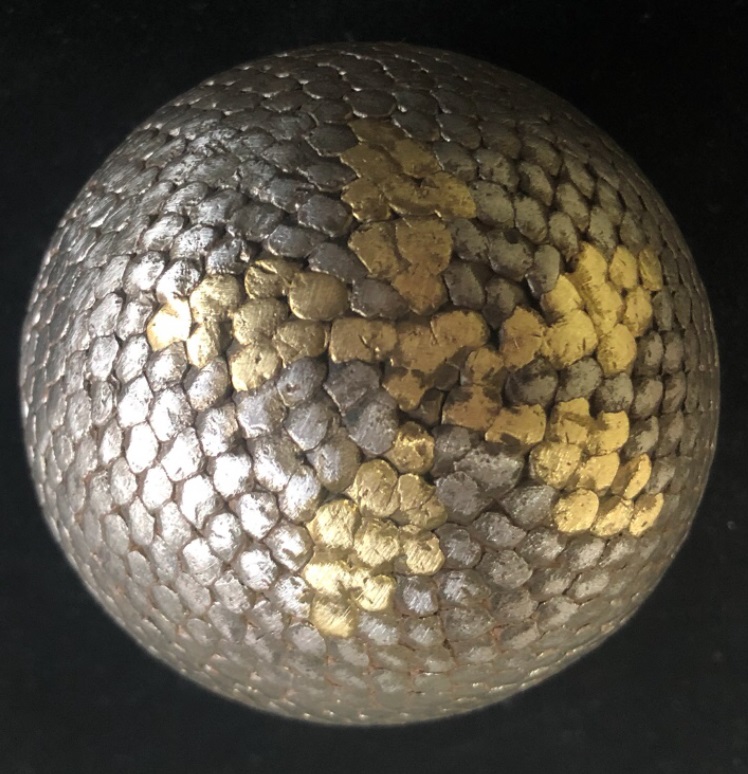
40/3) 40/3) Two boules acquired via an advertisement six months after having received those which precede (40/2a and b). There is like a family resemblance…

41) Probably, each craftsman had its little tips, tricks and own nails. Here is another example: to the left smooth thin scales and to the right, thick and convexly curved scales. Result: the boule on the right is less smooth but heavier.
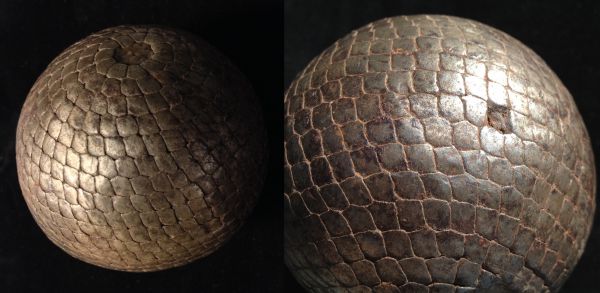
42) Two pics of the same ball (90mm) covered with finely adjusted nails against each other. On the right the empty slot shows that there is no overlap. Two ‘’click‘’ to see that some nail heads have 4 sides while others have 5 or even 6 sides, sometimes with straight or curved sides. Seeing these differences we can imagine that the nails were not made mechanically.
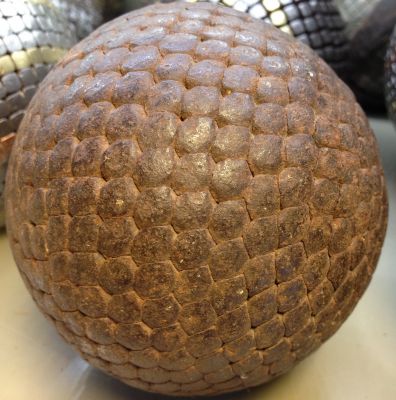
43) This one, surely not easy to achieve either.

44) Hand-forged nails. Clicking on the image shows that nailheads 1-2 and 4 have three different sides, a thick and a thin one at the opposite. Both lateral sides goes in degraded. These nails were removed from the ball below. The n°3 is the final locking nail on the image below, thin head of equal thickness.
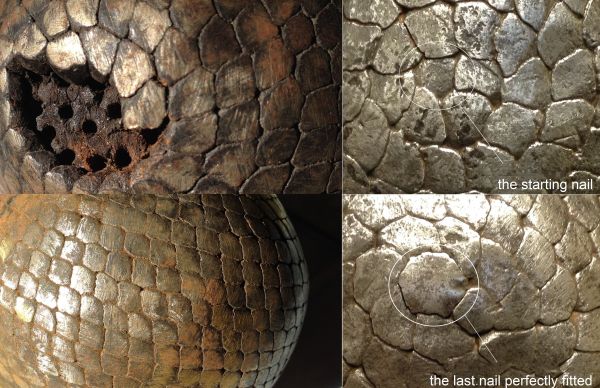
45/1) Above, the hole shows the thick side of the nails heads. Both balls are twins. The lower one is undamaged, two ‘’click‘’ to assess the accuracy of adjustments.

45/2) Thank to the traces left by the tool we can see that the raw heads of forged nails were filed to smooth their appearance. The lack of continuity in the sense of lime shots indicates that this operation was prior to studding, on each nail individually. (see also 66)
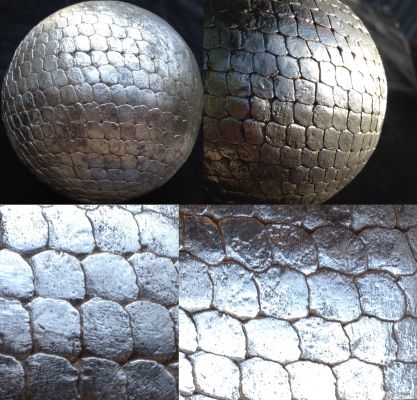
46) This is the unspoiled ball (pic 34 bottom left) after stripping. The thick side of the nails towards the left and the thin side towards the right. A meticulous work executed with extremely rustic nails (pic 33) however, a particularly neat and smooth appearance with a very strong anchor.
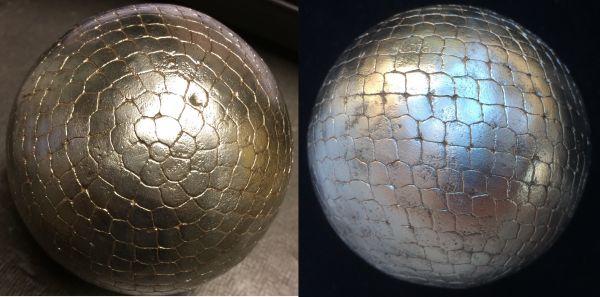
47/1A) Impressive little ball. In front of such a fit of nails, we ask ourselves the question: ‘’but how did they do it?‘’ However, the perfectly smooth appearance of some balls is explained: to get the spherical shape boxwood balls were machined on a wood lathe but some of them had to pass again on a metal lathe after nailing (ferrage). This perfect finish ‘’high-end‘’ of the boules was mentioned in the list under the term ‘’retournées‘’ (see image below)

47/1B) At the bottom of this document from the 1930s we find the mention ‘’boules retournées après ferrage‘’ this means: after nailing, the ball has a second pass on the metal lathe.

47/2) Each nail head is different and all these shapes fit together perfectly, even the rounded ones. An explanation would be welcome.

48) The start of the nailing … besides to various kinds of nails, looking at these three balls, there are several forms of starting of nails. To begin, let us look at this balls where nails go directly in spiral.
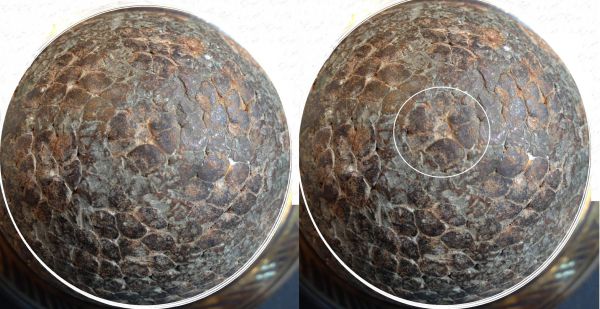
49) The start of the nailing … then those whose spiral is begining after a first circle of nails or sometimes after two concentric circles.
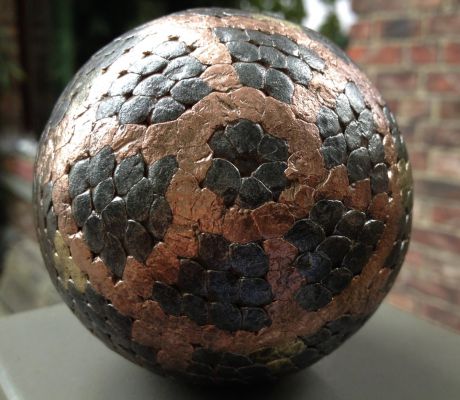
50/1) The start of the nailing … the same ball (37) where the upper half has been stripped and sanded. This treatment was unavoidable to recover the original colors. Small, with a diameter of 75 mm it is heavy (550g) and lived. The copper scales are crushed by countless impacts and they merge but it has not lost one nail and kept its perfect spherical shape. After the first circle of iron there is a second one in copper nails from which the spiral begins.
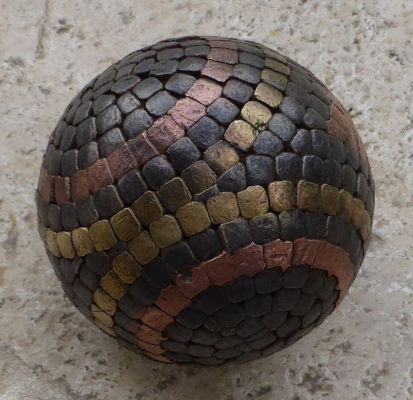
50/2) On this ball, to get an attractive appearance, in addition to steel, the ‘’ferreuse‘’ chose gilded brass (or bronze … here, I hesitate) and also red copper. She could not abuse with copper because too soft. As can be seen after clicking on the picture: under the effect of the impacts, the copper filled the spaces that remained free, proving that the ball had played a lot. Other photos on this blog show this phenomenon of soft metal migration to close interstices. See 50/1 – 62 – 67 and 73.

50/3) On this beautiful ball too (97mm / 984 gr) with a ‘’click‘’ we can distinguish particularly well the migration of soft copper in the interstices, the process is even more obvious by comparison with photos 50/1 – 62 – 67 – 73. This boule has obviously played a lot and yet it hasn’t lost a single nail.
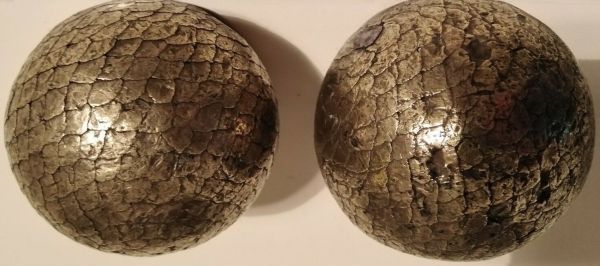
51/1) These perfectly smooth balls entirely covered with scales are perhaps unique pieces. Initials, drawings and other patterns made in softer non-ferrous metals generally appear on balls covered with square-headed nails, rounded flattened or hexagonal but not or little on balls with scales. It is obvious that the heads in brass or bronze has a poor resistance to shocks, see picture 50/1, on the long run copper nails merge together or merge with the heads of the iron nails. This is probably the reason why no, or almost no, balls have been decorated with such thin scales of nonferrous metal.

51/2) One of the balls above after grooming. It may be gold? 😉 – Diam: 70 mm. (the truth… brass)

51/3) Women and children – 70 or 71 mm this is very small. The information received to date (Mr A. Zenasni) confirms that it would be balls for women or children with a size adapted to their hands, about the little golden boule above (51/2), the touch of femininity seems to be obvious.
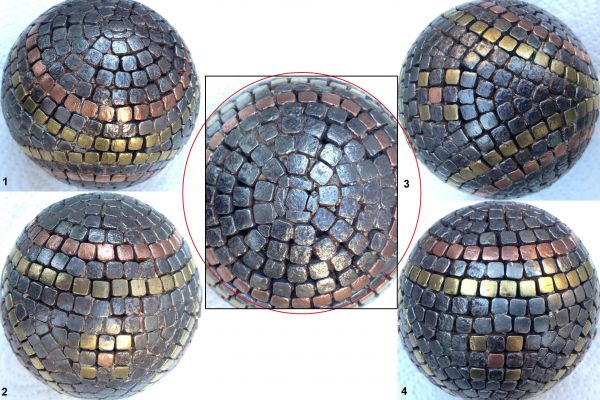
52) The start of the nailing … this one shows nested configurations. Central picture: the start point is composed of a nail surrounded by small rectangular spiked heads, then there are seven concentric circles, the last one is composed of brass nails. This forms a figure which is found three times on this ball (fig. 1). These 3 large geometrical shapes forms 3 triangles (fig. 2). At the center of the triangles a square pattern in copper and brass was inserted. (fig. 3 & 4).

53/1) The start of the nailing … another beautiful realization. Here, the start point is an hexagonal nail, surrounded with triangular heads. The result is very aesthetic. The nails appear to have been forged.

53/2a) The start of the nailing … twins in perfect condition, two large ‘’boule lyonnaise‘’ (1.026 gr / diam. 95 mm) their patterns are simple but very decorative. Here they are side by side for comparison, one in its original state and the other after stripping. See the rest of the commentary under the photo below.

53/2b) The start of the nailing … this is a variant of the composition of the 53/1 ball, the start is composed of a central square nail surrounded by nails with a triangular head then a circle of nails with larger head but also adjusted. Then there is the circle of brass nails from which lines start like meridians.
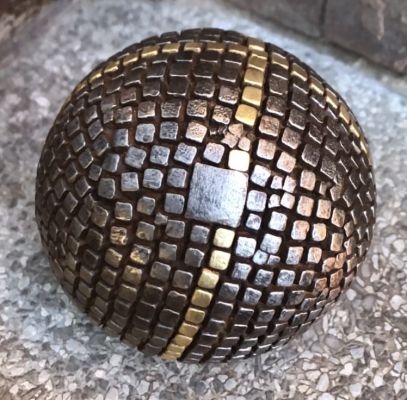
53/3a) On this ball you see an odd detail, one nail with big square head. This is a touch of originality, unless I’m mistaken this had never been seen until January 2021. (click)
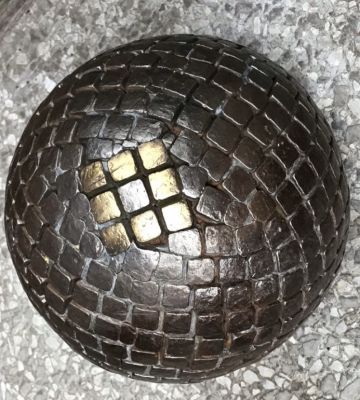
53/3b) Again about squares… here, brass nails have been arranged in a different way to create an original pattern. This figure is reproduced four times on the ball. (90mm-1kg)
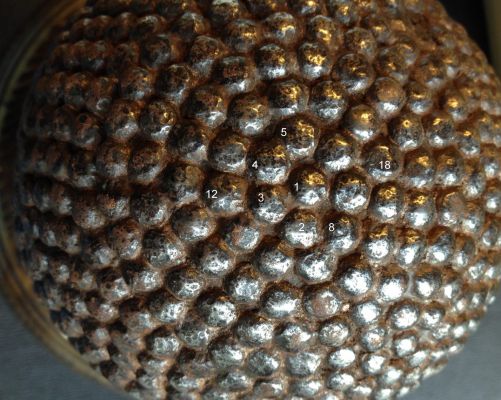
54) The start of the nailing … an old rustic ball perfectly realized (see also Fig 5) The starting point is not easy to detect: 1 or 2 ‘’click‘’ to enlarge and better see the starting point of the spiral.
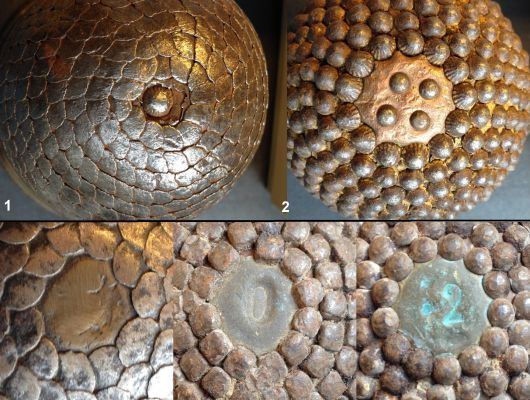
55) The start of the nailing … some balls have an area that seems to be ‘’leaded‘’ at the point of start of the nails. It is a metal disc, initials or numbers are often engraved on it. Nails can pass through this plate for a more solid anchorage to the wood of the ball.

56) The start of the nailing … non-standard configurations: the vacuum was filled by small nails, it is a cobbled restoration. To the right a more enigmatic case: the area is occupied by what looks like a big screw perfectly adjusted.

57) The start of the nailing … and finally, balls without apparent starting point. On the periphery, appears four times this oblong configuration with pointed ends where the nails are ‘’arranged‘’ which gives the assembly a good finish.
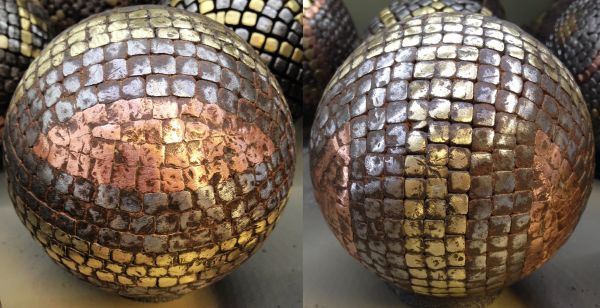
58) The start of the nailing … another ‘’boule‘’ with four oblong configurations in copper nails. A beautiful ball garnished with brass bands and yellow copper nails.
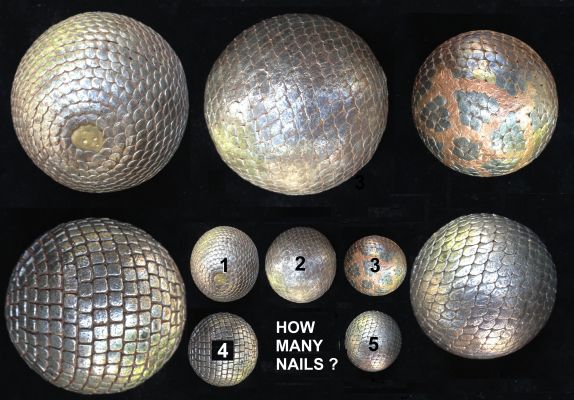
59) To follow, the answer to the question that everyone is wondering: ‘’How many nails on one ball‘’? Some examples taken here and there. Ball 1: 1136 – Ball 2: 996 – Ball 3: 1154 – Ball 4: 628 – Ball 5: 1.174. In conclusion, contrary to the type of nailing, the size has no significant impact on the number of nails.
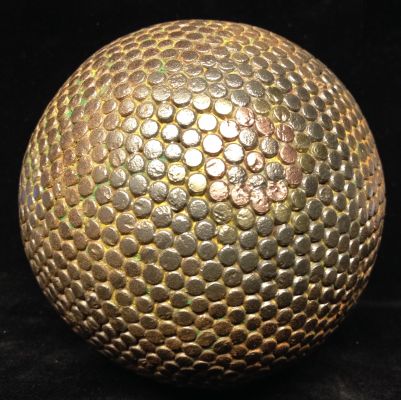
60) … How many nails? This ball of 98 mm exceeds all the other with about 1.655 small nails perfectly placed. Note that none of them had moved.
61) Boule covered of nails with hexagonal heads of different metals to obtain colorful patterns.
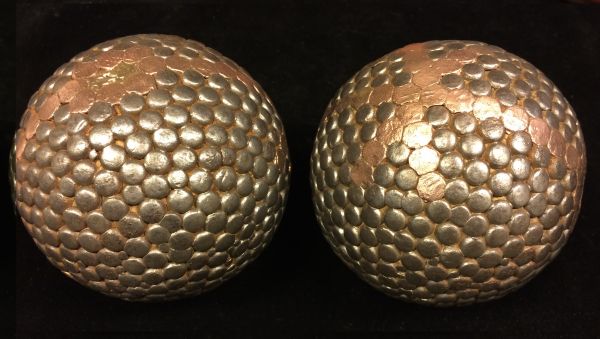
62) The iron heads are still hexagonal but domed. Copper nails were inserted. Softer, they end up occupying the open spaces. (92 mm)

63/1) A rare particularity: 100 mm x 896 gr – the nails heads sometimes pentagonal, hexagonal or octagonal are punched out in their center. (click-click)

63/2) Some boules deviate from the usual patterns regarding their design or the used materials. This one has nothing to envy to the other enigmatic balls. (ex: 19/1 and 19/2) By examining the variety of nails used and the work done on some heads for a better nesting (click) we understand from where its originality comes from.
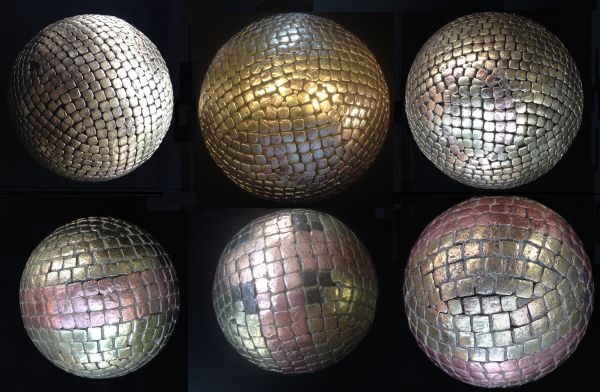
64) Just for fun, some pictures of beautiful balls in several nonferrous metal.
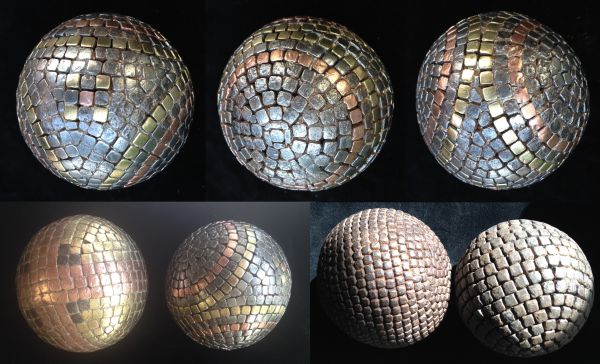
65) Nonferrous again… except the 2 bottom right.
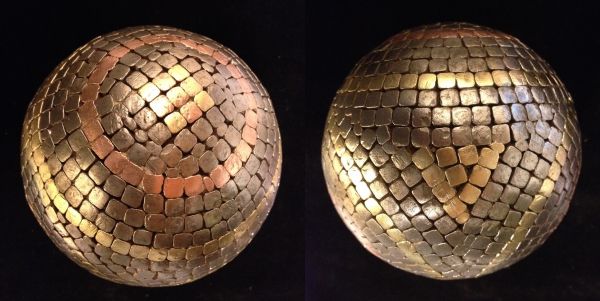
66) Some again… and even as told at top of this page: Each ball has his own story, some are pieces of art and more than any other object it passed from hand to hand. Many are artworks with an additional feature: artwork constrained to survive the shocks and other mistreatments.

67/1) It goes without saying that in case of suspicion of beautiful colors or of an interesting decoration, cleaning or pickling is required. Here, before … and after treatment. Two ‘’click‘’ to see how some red nails (softer than the others) fills the vacant space, due to the violent shocks.
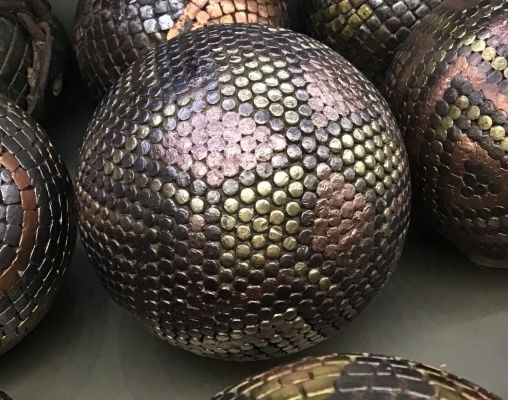
67/2) Click to see what this ball looked like when it was found; like many others she has spent a lot of years in an attic, a cellar, a barn or worse yet outside in the dam. A good stripping made it wanna show off again. (1.071gr – diam.102mm)
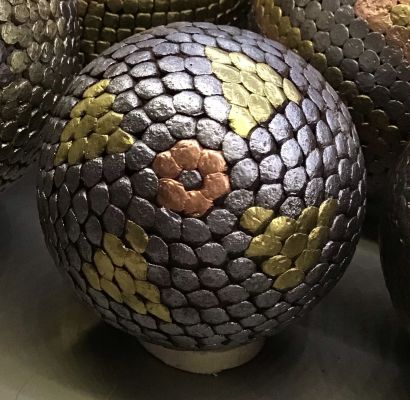
67/3 A nice little compact and solid ball where not one nail is missing (516gr-72mm) A feast for the eyes. As for its story, in view of the impacts on the scales she lived many ‘’parties de boules‘’. Click on the picture to see the corrosion layer at the time of his arrival, before the scouring.
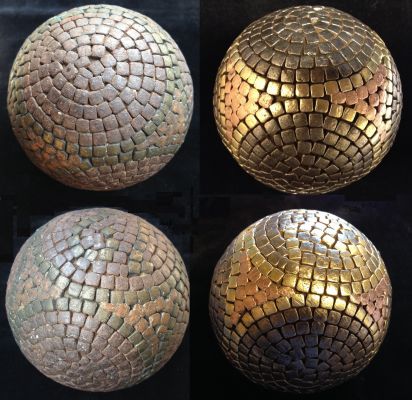
68) Another picture ‘’before-after‘’ that reveals the beauty of the ball. Here too, some red nails have merged.
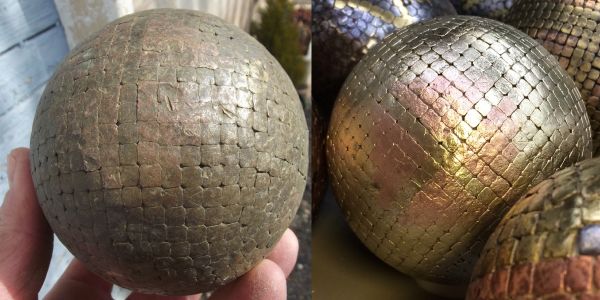
69) Here again a pleasant surprise after sanding: the ball is completely covered with bronze and brass.
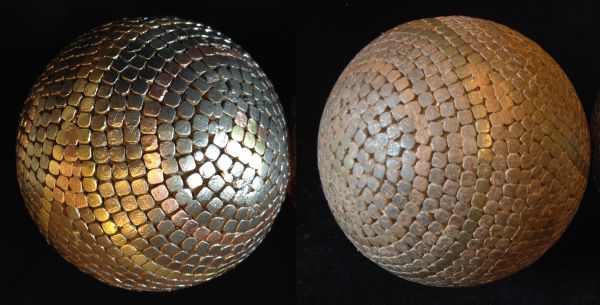
70) Big ball of ‘’Lyonnaise‘’ diameter 102mm, weight 1.130 gr. Dubble ‘’click‘’ on the picture to see the traces of the file. Nails heads were filed for a nice appearence.
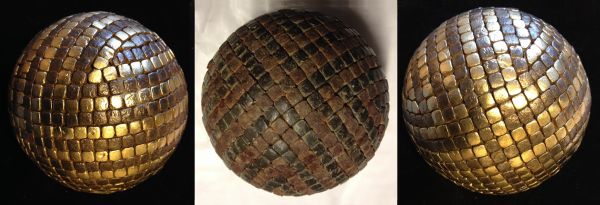
71) … here too, a good sanding to regain its beauty.
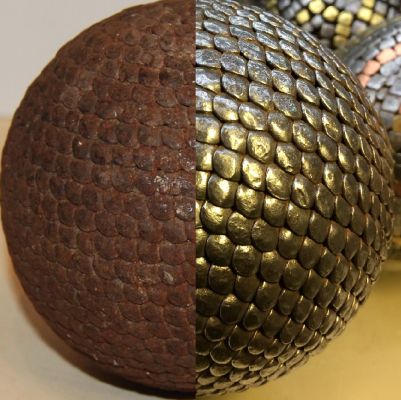
72) just to compare: before and after
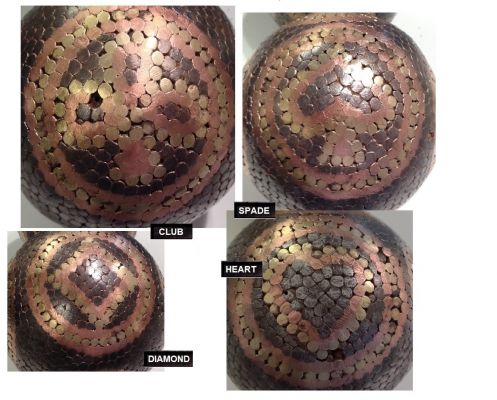
73) A pleasant surprise because the patterns were hidden behind an oxidation layer.
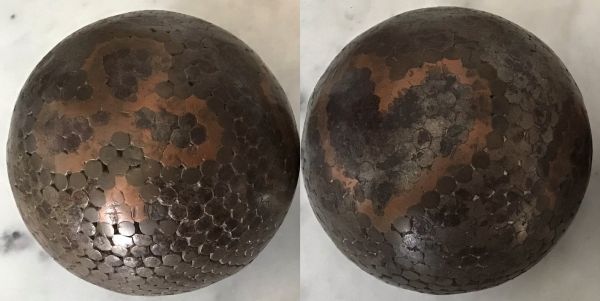
74/1) Here is another pair showing the symbols of the card game. Two balls in their current state. Click on the image to see the difference without the oxidation layer. We can imagine the satisfaction of its buyer in the 1920s (with a tolerance of 10 years … in both directions)
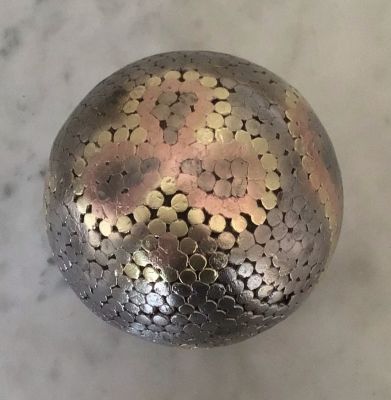
74/2) Great thanks to Mr Pierre Courty (France-Nîmes-Gard) who made this great acquisition possible. One click to see the four symbols.

74/3) On this picture they are presented in the raw state. But… to sand or not to sand, that is the question! (And in fact, one of the two remained in its original state)
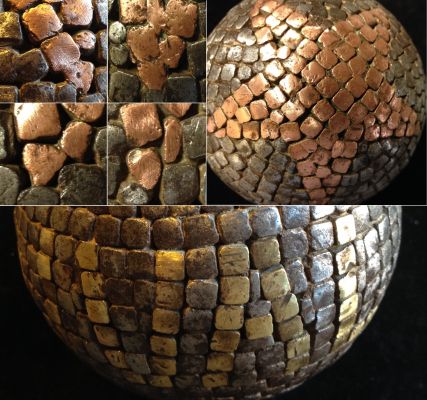
75) Over the months, new balls are installed on this page because they have something original. Here, two balls (95mm) identical and intact despite a lot of traces of impacts that attest to their hard experience. The ball above shows a star with five branches, the same decorates its base. The artist did not content himself with placing the nails in order to make a star with approximate branches but each head has been worked in such a way to be triangular, rectangular or round in order to make a more perfect star, and the same for iron nails. Between the stars, the name ‘’DUVALET‘’ in large characters.

76) ‘’DUVALET‘’ is probably the longest inscription found on a ball so far. Both boules were by chance discovered in 1972 during refurbishment works in a cellar. (Pezenas in France/Hérault)
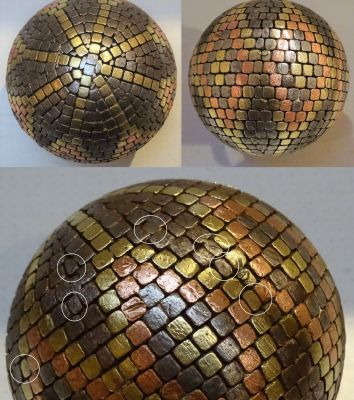
77) Aligning square heads on a round ball is not easy, but placing figures with angles is less so. Up and down, on this highly decorated ball the ‘’ferreuse‘’ inserted many nails made to measure to fill the spaces. (click)
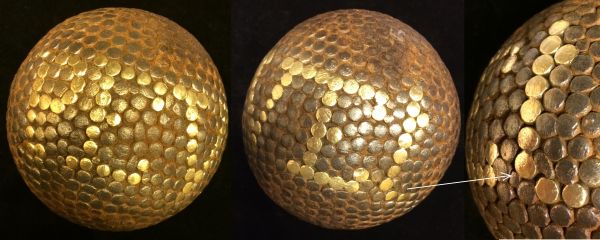
78) Another discovery, this strange ball with the inscription ‘’PEVEt‘’ which ends with a small ‘’T‘’.
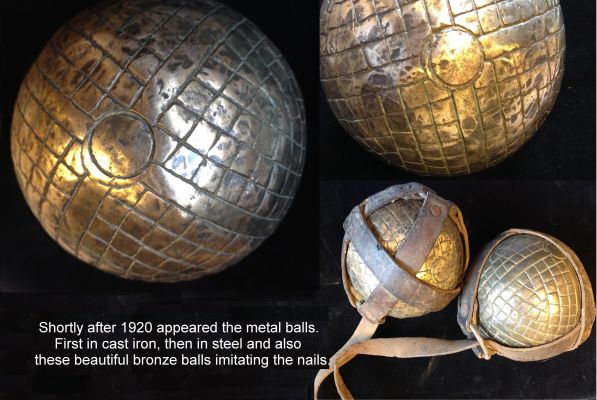
79) The succession. Bronze or brass ? That is the question…
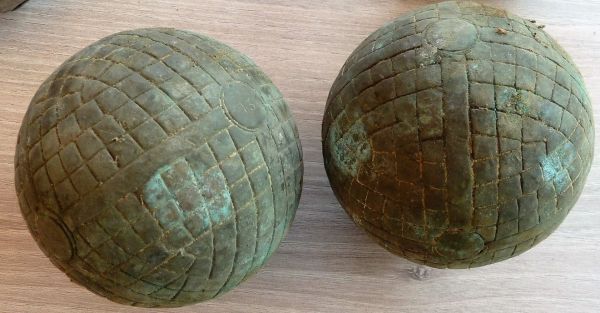
80) Before their restoration. Oxidation and nuances.
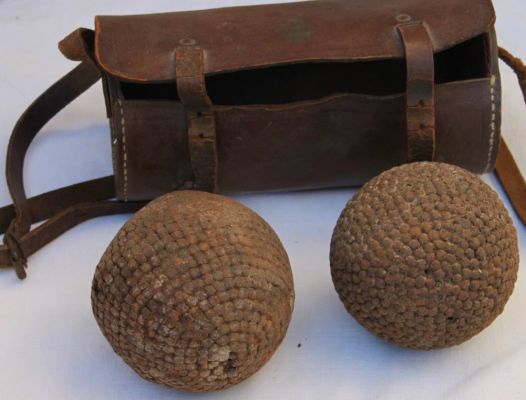
81) Such they are found in basements or attics, two balls shaped by the time with their own stories and experiences. Below, another discovery…
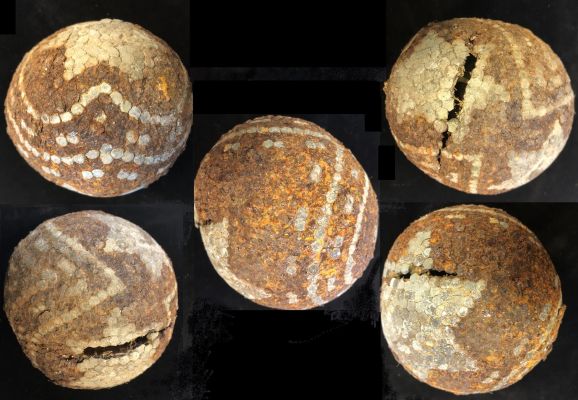
82) At the ‘’Moulin de Cornevis‘’ (Privas in Ardèche) an almost archaeological find during restoration work, deep in a cellar, some old objects were saved from oblivion including 18th century porcelain and this boule which must have enjoyed its glory days and should not remain unnoticed with its copper and brass nails. (left in their oxidation state) Note: the detail of the small nails grouped in pairs, a unique pattern never seen until today. (Feb. 2020)

83) As it was found in an old photo album or on postcards, a player of the time on its Sunday best playing pétanque… with studded balls.
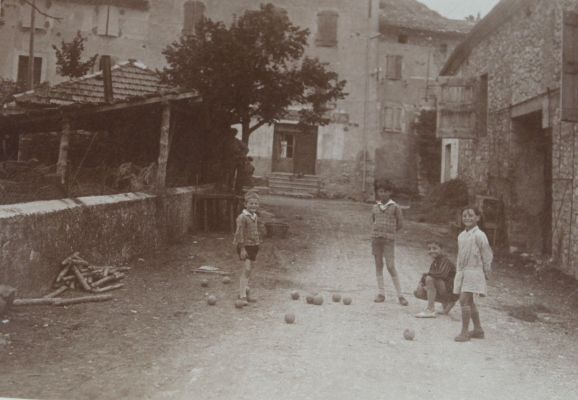
84) In the 1950s, life in the village was very different from life in the cities. These kids are training with boules that look like they’ve lived well. (click)
Flea markets and Internet ads offer them a new life for the satisfaction of hobbyists of fine objects. There is a lot to tell about the game, the balls and their manufacture. Experts have done it very well, here’s some links: http://www.francepetanque.com/LRA/pages/histoire/page6.htm a beautiful website. Finally, not to be missed, the website of Herbert Wegner quite complete, with its english version after reading it you will know all about the studded balls: http://herbert.wegner.pagesperso-orange.fr – On Isaac Brooks‘ Facebook page full of treasures from the past, see this authentic ancient document https://www.facebook.com/contact.isaacbrooks/videos/3565298793585006 a game of ‘’Longue lyonnaise‘’ – At the sight of the bounce of the balls, they would be made of wood, it was just before the studded balls.
Hever – Boortmeerbeek (Belgium)
Updates 2023 03 03
picture 22/2 + USA: Steve Ferg 24+35
Instagram: https://www.instagram.com/amelotomb/
